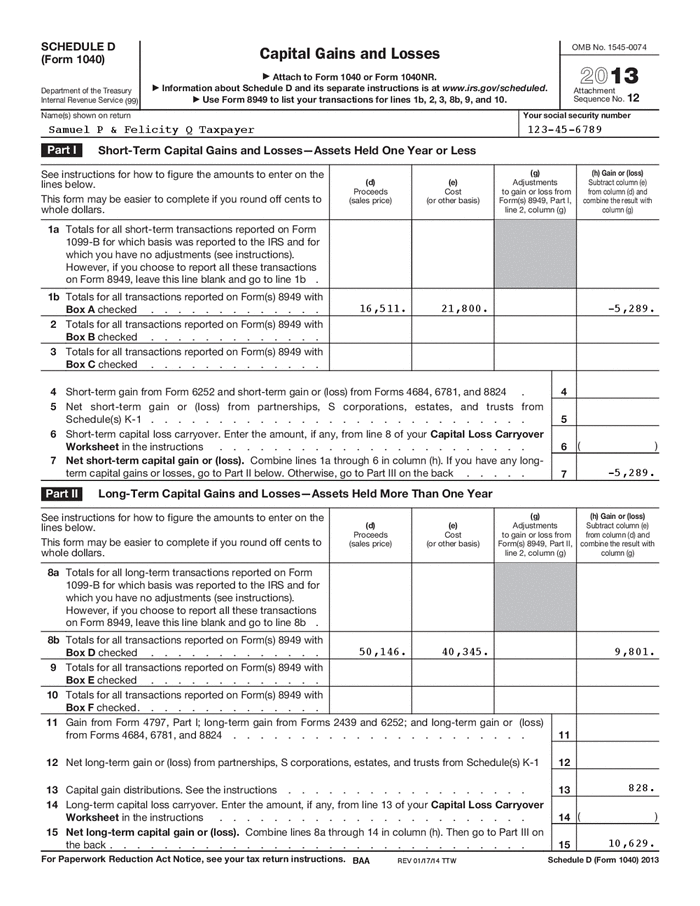New Tax Forms for Reporting Capital Gains and Losses
Post on: 21 Апрель, 2015 No Comment

New Form 8949 to be used starting in 2011
The IRS has unveiled a new tax form for reporting capital gains and losses from stocks, bonds, mutual funds and similar investments. Starting with the 2011 tax year, investment transactions will be reported on the new Form 8949, Sales and Other Dispositions of Capital Assets. A pdf version of Form 8949 is posted at the IRS Web site; instructions for this new form is included with the instructions for Schedule D. The IRS has also revised Schedule D and Form 1099-B.
Back in 2008, Congress passed the Emergency Economic Stabilization Act. which required that brokers begin reporting the cost basis of investment products to investors and to the IRS. In theory, having brokers report cost basis along with sales proceeds on the Form 1099-B will greatly reduce the burden on individual taxpayers to maintain extensive records on their investments and could simply the tax reporting process.
Brokerage firms send out a Form 1099-B to report the sale of an investment product, such as a stock or mutual fund. Previously, the 1099-B reported information about the sale of the investment (such as the date of sale and the sale proceeds). Taxpayers then needed to supply the purchase date and purchase price when reporting the transaction on their Schedule D. Many brokers already provided gain/loss reports as supplemental information with their annual reports. Starting in 2011, cost basis information will be included directly on the 1099-B if the broker is required to supply that information. Whether a broker is required to provide cost basis information depends on whether the investment is a covered security . Brokers are required to provide cost basis for stocks acquired during 2011 (or later), for mutual funds and stocks in a dividend reinvestment plan acquired during 2012 (or later), and all other investment products acquired during 2013 (or later).
The IRS has substantially revised Form 1099-B to facilitate this cost basis reporting. The IRS has also substantially revised Schedule D and created a new Form 8949. Starting with 2011, Schedule D now functions as a summary of all capital gains transactions. Individual investment sales are to be detailed on the new Form 8949.
Any particular investment sales transaction will fall into one of three categories:
- Sales of covered securities for which cost basis is provided;
- Sales of non-covered securities for which no cost basis is provided on the 1099-B; or
- Sales of investments assets for which no 1099-B is received.
The new Form 8949 reflects this categorization. A separate Form 8949 is required for each type of transaction, with the appropriate check box indicated at the top of the form. Form 8949 is further divided into two pages, with short-term transactions being listed on page 1 and long-term transaction listed on page 2.
To phrase this a different way, there will be one Form 8949 reporting capital gains and losses where cost basis is provided (check box A), with short-term transactions listed on page 1 and long-term transactions listed on page 2. There will be a separate Form 8949 reporting capital gains and losses with cost basis in not provided (check box B), with short-term transactions shown on page 1 and long-term transactions shown on page 2. And there will be a third Form 8949 reporting capital gains and losses where Form 1099-B was not received (check box C). Thus it is possible for a taxpayer to have one, two or three Forms 8949 (one for each check box).
Totals from these separate Forms 8949 will be summarized on the newly revised Schedule D. The structure of the new Schedule D mirrors the structure of Form 8949.
Taxpayers will also notice that Form 8949 has two columns that are not present on the previous version of Schedule D. New Form 8949 has a column B to report a Code and has column G to report Adjustments to gain or loss. The column B codes are used to indicate the a transaction has some sort of special treatment, such as a wash sale, section 1202 gains, small business stock gains, the sale of a main home, or if the basis reported by the broker is incorrect. Taxpayers will be able to correct the cost basis of a particular transaction by reporting the basis as reported by the broker in column F and then making any adjustments or corrections in column G.
Cost basis reporting by brokers will never fully and completely eliminate the need for taxpayers to maintain their own records. That’s because basis reporting will be phased-in and applies only to newly acquired shares. Stock purchased prior to 2011, mutual fund shares purchased prior to 2012, and bonds purchased before 2013 won’t have basis reported on the 1099-B. That information will likely be found in other reports or data, such as brokerage statements, year-end reports or trade confirmations .














